Bhakarwadi recipe with step by step pics. One of the popular snack from western India is bhakarwadi. These are also named as bakarwadi. Basically bhakarwadi are fried and crisp pinwheels or spirals. These are addictive and have a sweet, spicy and tangy taste. They make for an excellent tea time snack.
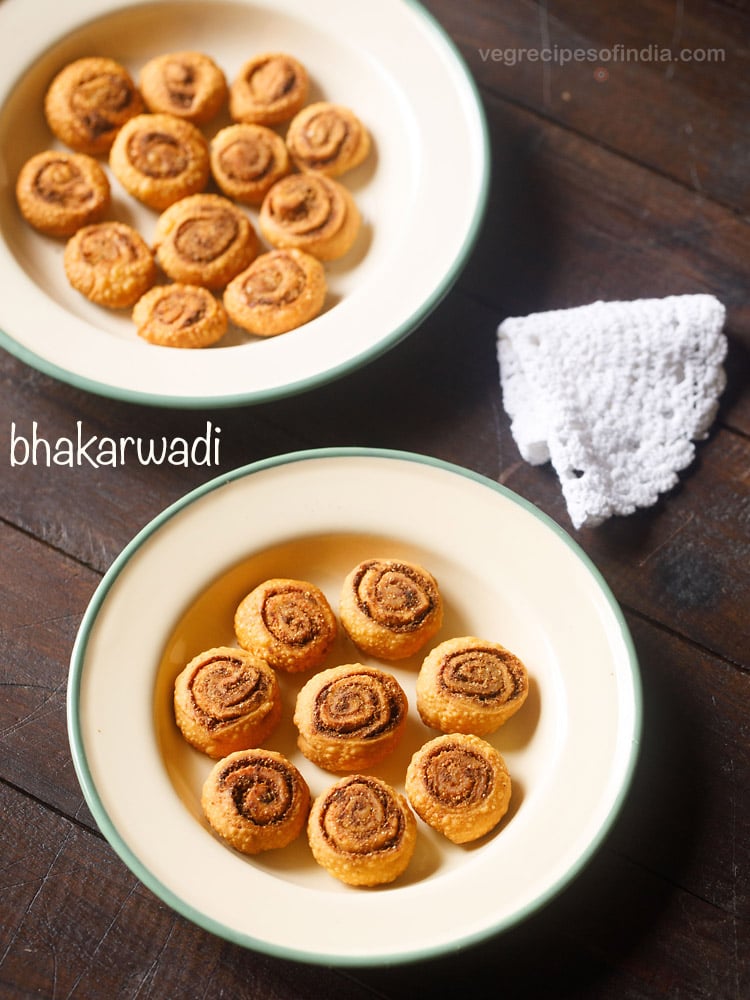
Broadly classifying, There are two versions of bhakarwadi – one from Pune, Maharashtra and the second from Gujarat. The bhakarwadi from Pune is popular, especially the bhakarwadi from Chitale Bandhu. This post shares the Maharashtrian bhakarwadi recipe.
In the Maharashtrian version of bakarwadi, the outer cover is made from gram flour (besan) and all purpose flour (maida) or whole wheat flour (atta). The stuffing has coconut, sesame seeds, poppy seeds with some spices added in it.
A souring ingredient is added to give a tang in the bhakarwadi. So ingredients like tamarind pulp, lemon juice or dry mango powder (amchur powder) are added. For the sweet taste, sugar is added.
Some versions of bhakarwadi also add sev (fried gram flour vermicelli). In this recipe I have skipped adding sev. Though you can add sev if you want.
After getting many requests, I am sharing bakarwadi recipe. Making bhakarwadi is easy but takes time. This bakarwadi recipe is not spicy. You can add more Kashmiri red chili powder for a spicier version. The one’s you get in the market are more spicy in taste.
Bhakarwadi makes for a great tea time snack. You can easily store bhakarwadi for many weeks in an air-tight jar.
How to make bakarwadi or bhakarwadi recipe
For ease of understanding, I have divided this bhakarwadi recipe post into 4 steps.
- Step 1 – making bhakarwadi dough
- Step 2 – making bhakarwadi stuffing
- Step 3 – assembling and making bhakarwadi spirals
- Step 4 – frying bhakarwadi
Lets start with step 1 – making bhakarwadi dough
1. In a mixing bowl or large tray or plate, take 1 cup besan (100 grams) and ¾ cup maida (90 to 95 grams). Also add ¼ teaspoon turmeric powder, 1 pinch asafoetida (hing) and ¾ to 1 teaspoon salt.
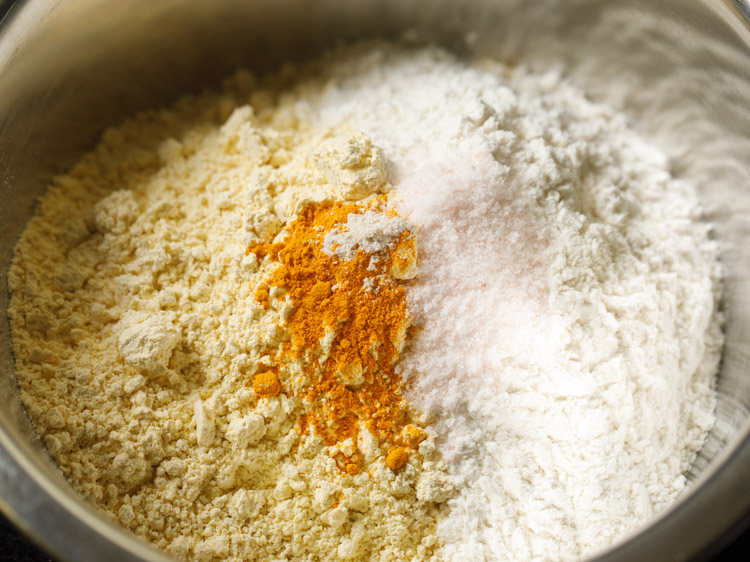
2. With a spoon mix everything well.
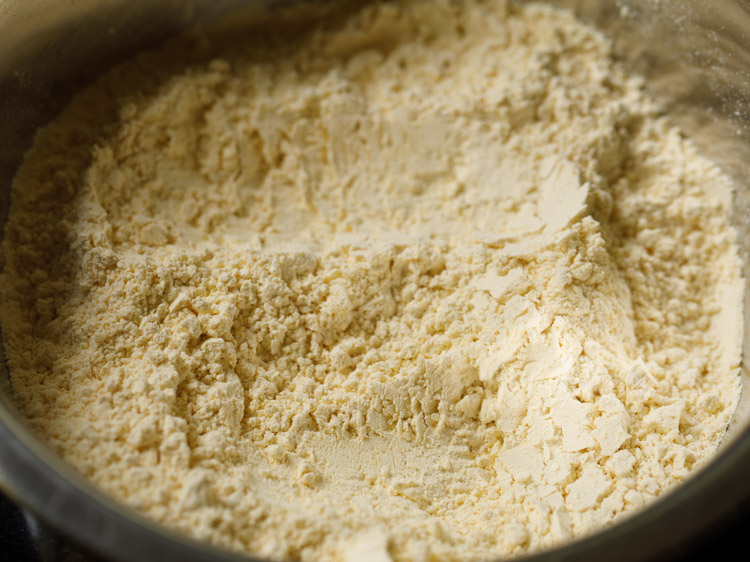
3. Next add 3 tablespoons oil.
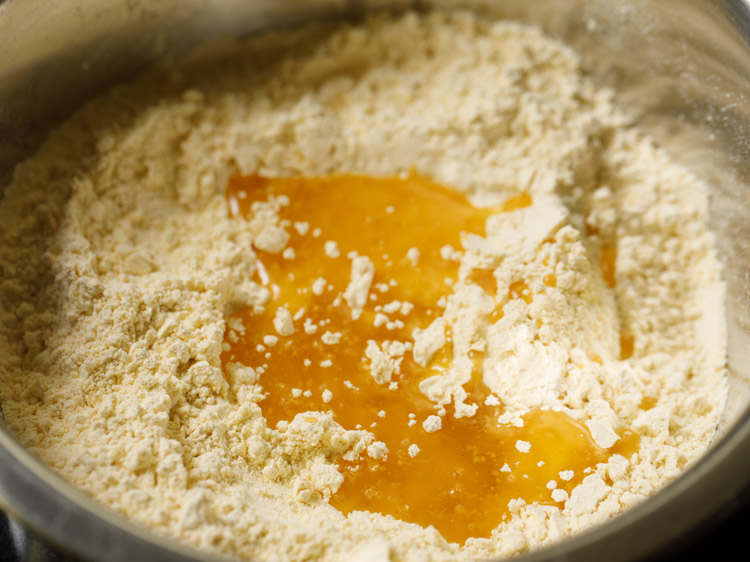
4. With your fingertips, mix the oil with the flours, till you get a bread crumb like texture. Take a portion of the flour and press it. It should be able to hold itself and not crumble.

5. Next add water in parts. Amount of water to be added depends on the quality of besan and maida, so add in parts and add as required. Overall you can add 4 to 5 tablespoons water or add as required.

6. Adding water in parts, begin to mix and knead the dough.

7. Knead to a semi soft dough. In case the dough becomes sticky, then add some maida. If it looks dry, then sprinkle some water and continue to knead. Cover the dough and keep aside.

Making bhakarwadi stuffing
8. Heat a heavy pan or kadai. Add 2 tablespoons white sesame seeds.
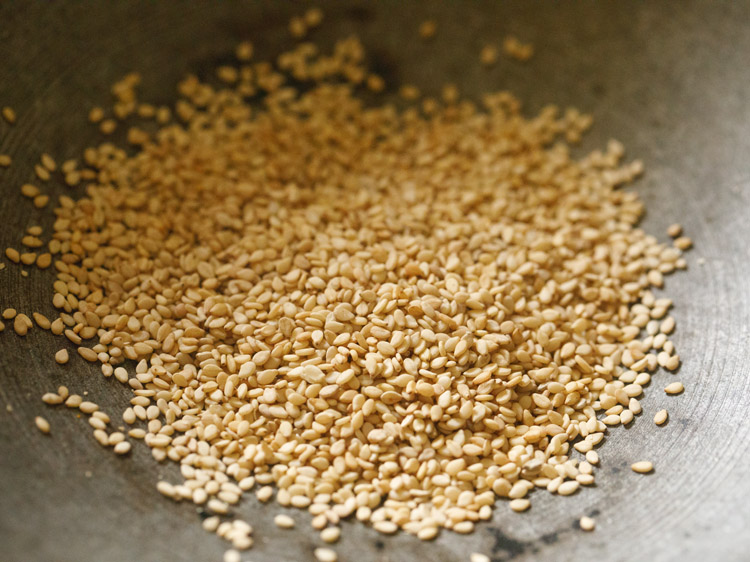
9. On a low to medium-low flame, stirring often roast sesame seeds till they crackle. Do not brown them.
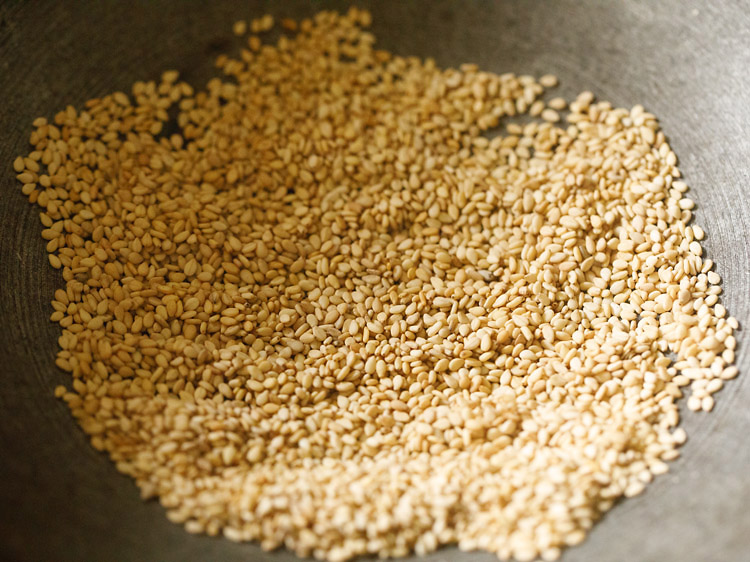
10. Keeping flame to a low, add ½ cup desiccated coconut (40 grams) and 1 tablespoon poppy seeds (khus khus).
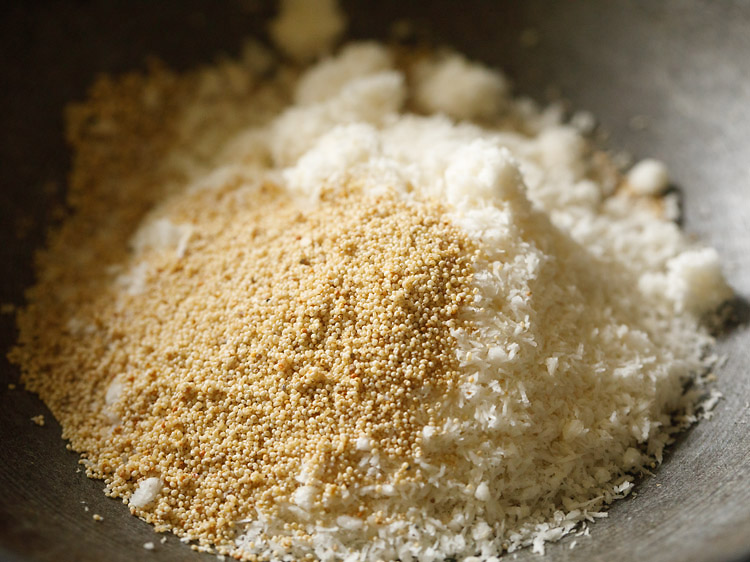
11. Mix very well.
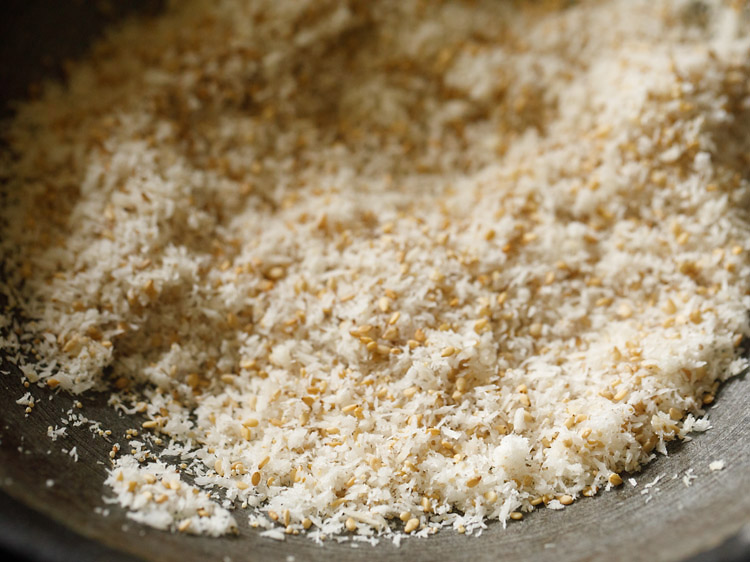
12. Add ½ teaspoon fennel seeds.

13. Mix again and roast on a low flame.
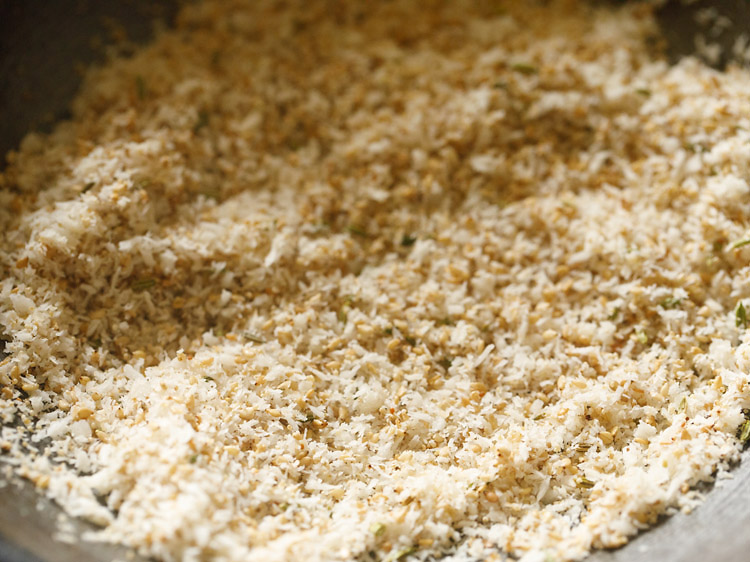
14. Stirring non-stop, roast till coconut is light golden.

15. Switch off the heat and keep the pan down. Add the following spice powders one by one – 1 pinch asafoetida, 1 teaspoon Kashmiri red chili powder, 1 teaspoon coriander powder, 1 teaspoon cumin powder and ½ teaspoon garam masala (or ½ teaspoon goda masala). Also add salt as per taste.
The spice powders will get cooked with the residue heat from the pan and the coconut mixture.

16. Mix very well and let this mixture cool.

17. Then take all of the roasted stuffing mixture in a grinder jar. Add 1.5 to 2 tablespoons sugar. You can add less or mores sugar as per your taste buds.
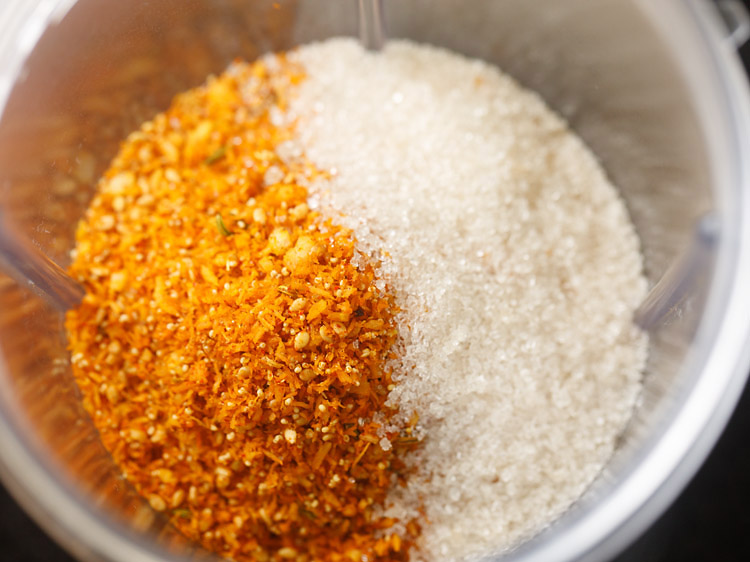
18. Grind to a semi fine powder. Do not grind fine as then oil releases from coconut and sesame seeds. Use pulse option and grind or grind in intervals of a few seconds.
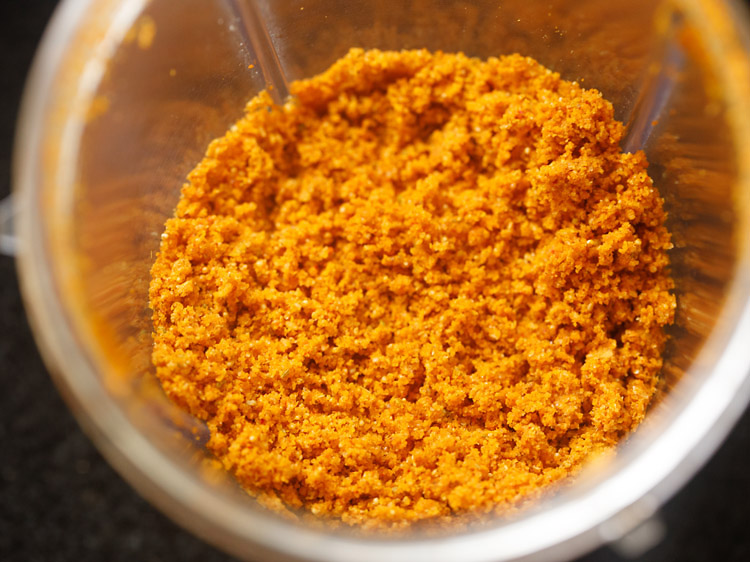
19. Take the bhakarwadi stuffing in a bowl. Add ½ tablespoon lemon juice. For a more tangy taste, you can add 1 tablespoon lemon juice.
Alternatively instead of lemon juice, add 1 to 2 teaspoons dry mango powder or 1 to 2 teaspoons of tamarind pulp (Note: not tamarind paste). The sourness can be made less or more, by adding less or more of the souring ingredient.
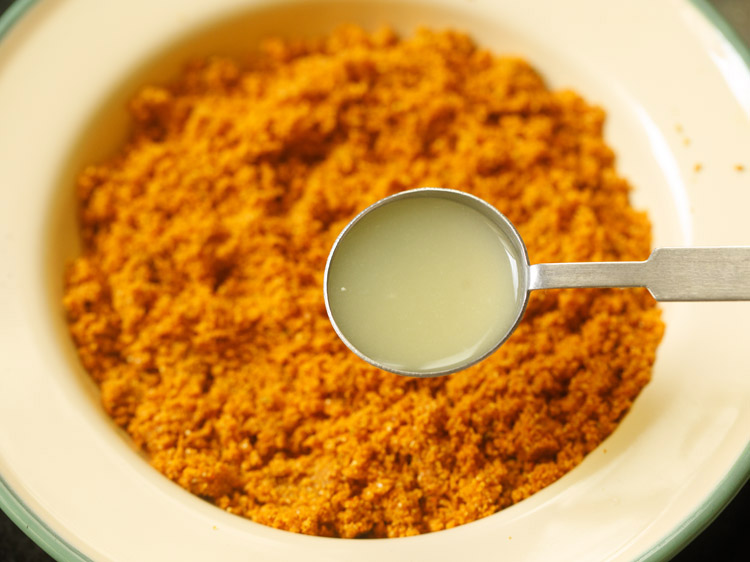
20. Mix very well. Check the taste and if required add more salt, sugar or spice powders or lemon juice.

Assembling and making bhakarwadi spirals
21. Take the dough and roll it into a log. cut the log in 4 to 5 equal parts.

22. Take one part of the dough and roll between your palms to get a round shape. Flatten and keep the dough on a rolling board.
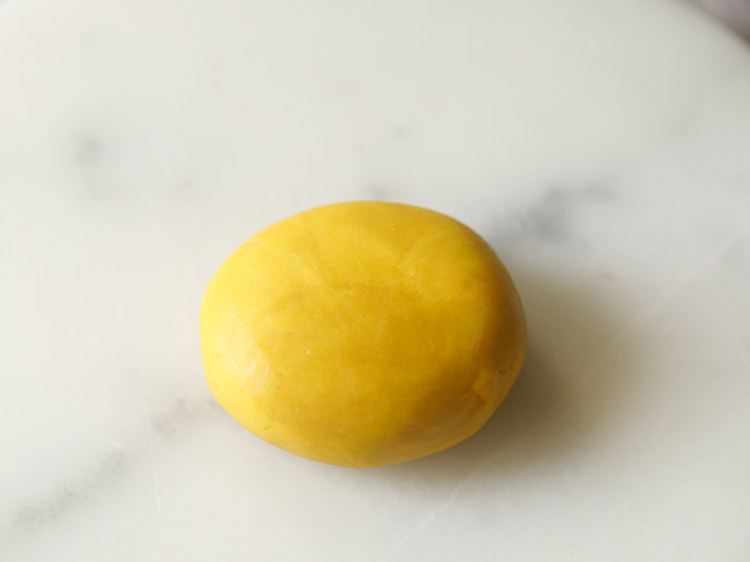
23. Sprinkle some besan before you begin to roll the dough.

24. Roll to a medium thick round or square or rectangle (whatever suits you ☺️). Make sure that the dough is not rolled thinly or thickly.

25. Now brush lightly with water all over the rolled dough.
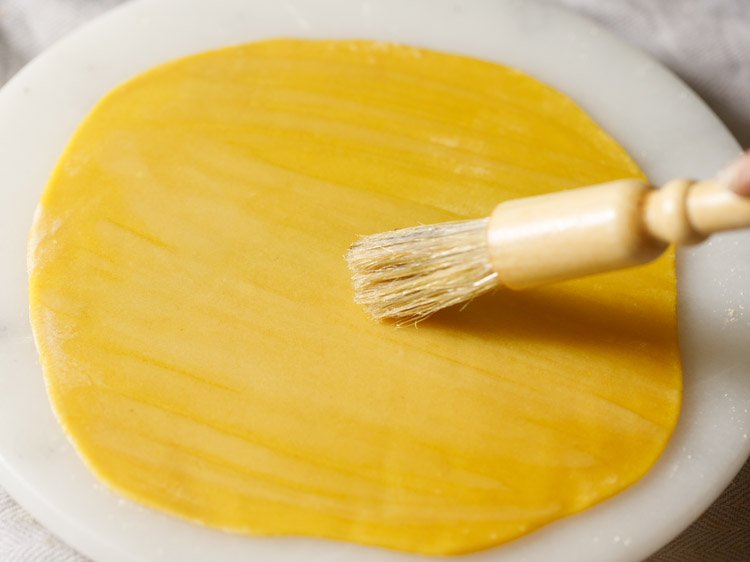
26. With a spoon spread masala on the dough, leaving a space of ½ to 1 inch at the edges.

27. Then lightly press the stuffing masala with a spoon.

28. Now begin to tightly roll the dough.
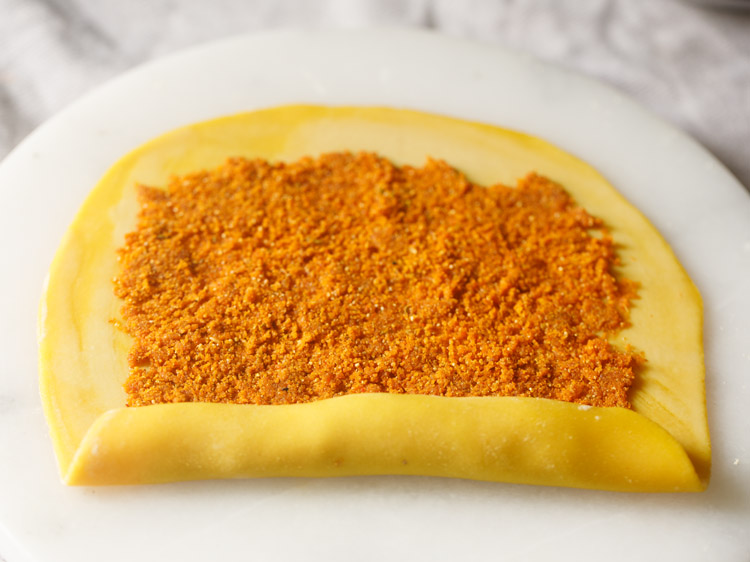
29. Roll to a tight and neat log.
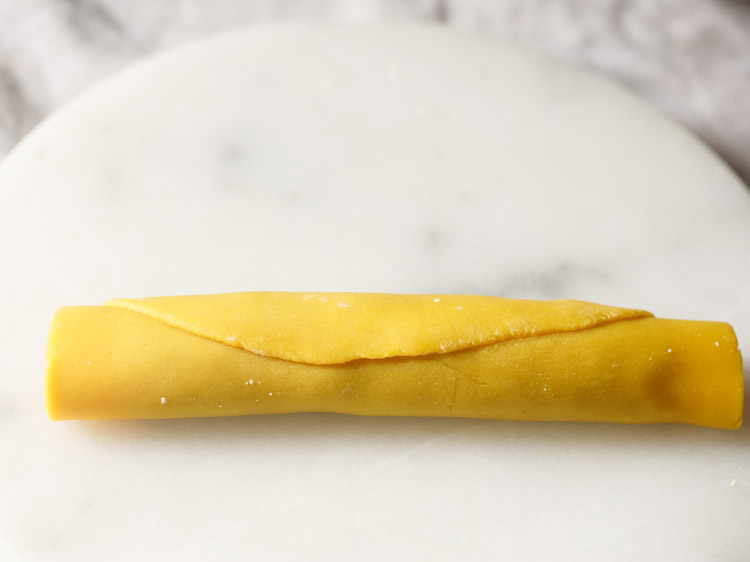
30. Join the edges.

31. Cut the rolled log in equal parts.
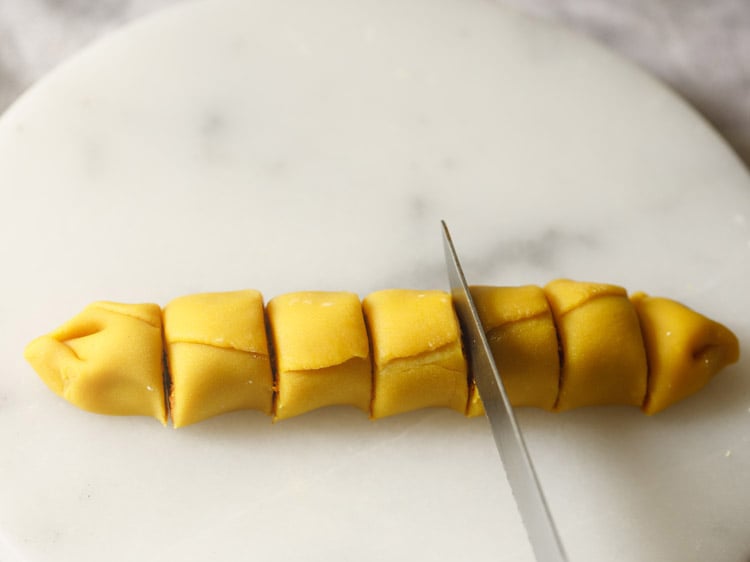
32. You will get the bhakarwadi spirals or pinwheels. Place them with the pinwheel surface facing you.

33. Gently press each bhakarwadi pinwheel with the heels of your palm.
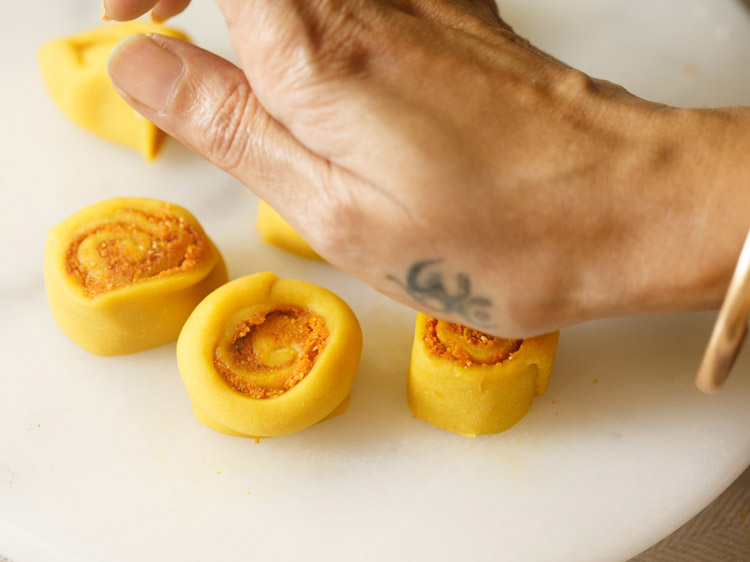
34. This way make bhakarwadi pinwheels with the entire dough and stuffing mixture. Keep them in a bowl. Cover the bowl.

Frying bhakarwadi
35. Heat oil in a kadai or pan. Keep flame to medium-low or medium. To check if the oil is hot, slid one bhakarwadi in the oil.
If the bhakarwadi comes up gradually to the surface of oil, you can begin frying bakarwadi.
If the bhakarwadi, comes up slowly on the surface of oil, then the oil is not hot enough – so increase the flame. If the bhakarwadi comes up too quickly on the top, then the oil is very hot – so reduce the flame.

36. Add the bhakarwadi pinwheels in the oil. Do not over crowd the pan or kadai with bhakarwadi.
Begin to fry at medium low to medium flame. Do not fry on a high flame as then the center of bhakarwadi can be slightly soft and uncooked.
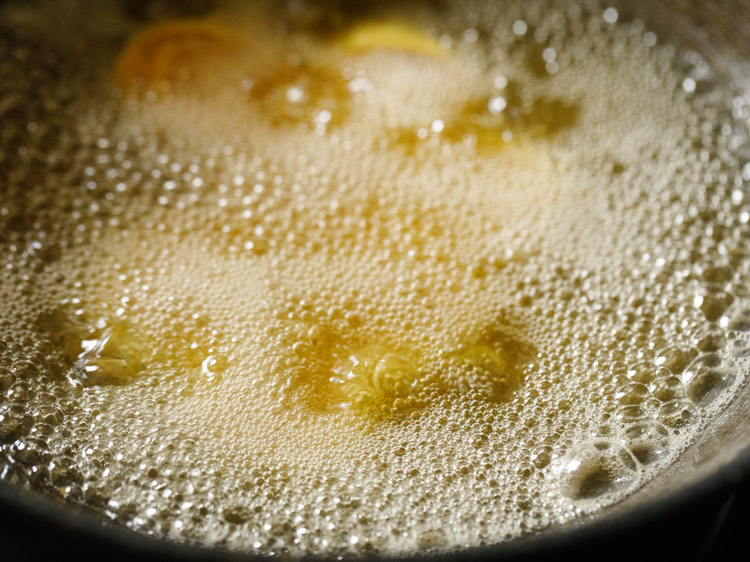
37. When one side is light golden, turn it over with a slotted spoon and fry the second side of the bakarwadi.

38. Continue to turn bhakarwadi a couple of times to get even golden color.

39. Fry bhakarwadi till the crust becomes crisp and golden and the oil stops sizzling.
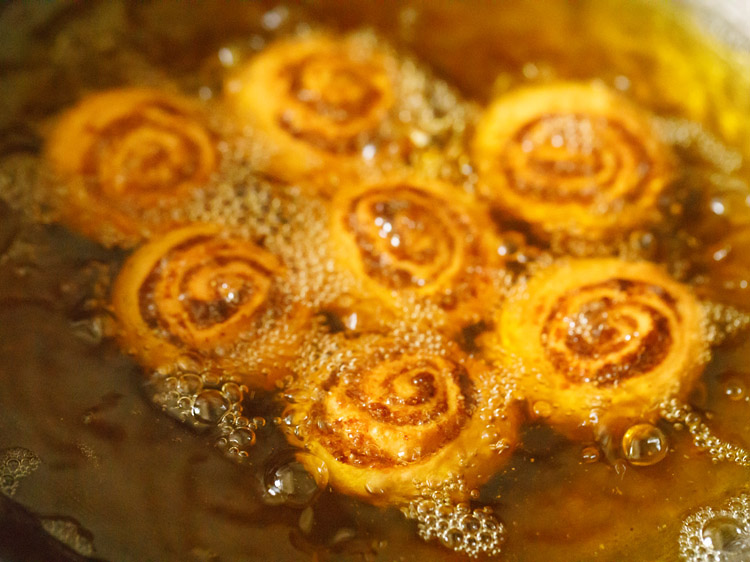
40. Remove the fried bakarwadi with a slotted spoon draining extra oil in the kadai itself.

41. Place the fried bhakarwadi on kitchen paper towels to absorb extra oil. Similarly fry the remaining batches of bhakarwadi.
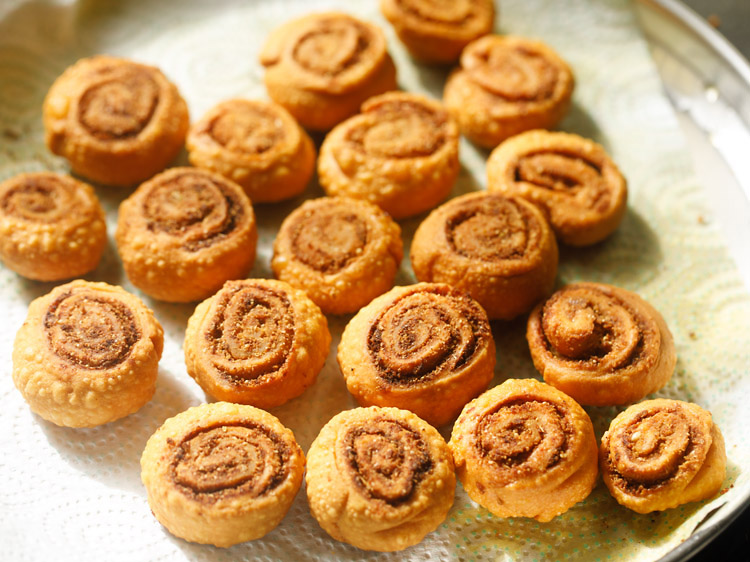
42. When they cool down at room temperature, then place them in an air-tight jar or box. This recipe yields about 25 to 26 bhakarwadi. Serve them as a tea time snack.

More tasty Snacks Recipes
Please be sure to rate the recipe in the recipe card or leave a comment below if you have made it. For more vegetarian inspirations, Sign Up for my emails or follow me on Instagram, Youtube, Facebook, Pinterest or Twitter.

Bhakarwadi
Ingredients
for bhakarwadi dough
- 1 cup besan or 100 grams besan (gram flour)
- ¾ cup maida or 90 to 95 grams maida (all purpose flour)
- ¼ teaspoon turmeric powder (haldi)
- 1 pinch asafoetida (hing)
- ¾ to 1 teaspoon salt or add as required
- 3 tablespoons oil
- 5 tablespoons water or add as required
for bhakarwadi stuffing
- 2 tablespoons white sesame seeds (safed til)
- ½ cup desiccated coconut or 40 grams (nariyal ka boora)
- 1 tablespoon poppy seeds (khus khus)
- ½ teaspoon fennel seeds (saunf)
- 1 pinch asafoetida (hing)
- 1 teaspoon kashmiri red chili powder
- 1 teaspoon Coriander Powder (dhania powder)
- 1 teaspoon cumin powder (jeera powder)
- ½ teaspoon Garam Masala or ½ teaspoon goda masala
- ½ tablespoon lemon juice or add as required
- salt as required
- 1.5 to 2 tablespoons sugar or add as per taste
- oil as required for deep frying
Instructions
making bhakarwadi dough
- In a mixing bowl or large tray or plate, take gram flour (besan), all purpose flour (maida), turmeric powder, asafoetida (hing) and salt.
- With a spoon mix everything well.
- Next add 3 tablespoons oil. with your fingertips, mix the oil with the flours, till you get a bread crumb like texture.
- Take a portion of the flour and press it. It should be able to hold itself and not crumble.
- Next add water in parts. Amount of water to be added depends on the quality of besan and maida, so add in parts and add as required. Overall you can add 4 to 5 tablespoons water or add as required.
- Adding water in parts, begin to mix and knead the dough.
- Knead to a semi soft dough. In case the dough becomes sticky, then add some maida. If it looks dry, then sprinkle some water and continue to knead. Cover the dough and keep aside.
making bhakarwadi stuffing
- Heat a heavy pan or kadai. Add 2 tablespoons white sesame seeds.
- On a low to medium-low flame, stirring often roast sesame seeds till they crackle. Do not brown them.
- Keeping flame to a low, add ½ cup desiccated coconut (40 grams) and 1 tablespoon poppy deeds (khus khus). Mix very well.
- Then Add ½ teaspoon fennel seeds. Mix again and roast on a low flame.
- Stirring non-stop, roast till coconut is light golden.
- Switch off flame and keep the pan down.
- Add the following spice powders one by one – 1 pinch asafoetida, 1 teaspoon kashmiri red chili powder, 1 teaspoon coriander powder, 1 teaspoon cumin powder and ½ teaspoon garam masala (or ½ teaspoon goda masala).
- Also add salt as per taste. The spice powders will get cooked with the residue heat from the pan and the coconut mixture.
- Mix very well and let this mixture cool.
- Then take all of the roasted stuffing mixture in a grinder jar. Add 1.5 to 2 tablespoons sugar. You can add less or mores sugar as per your taste buds.
- Grind to a semi fine powder. Do not grind fine as then oil releases from coconut and sesame seeds. Use pulse option and grind or grind in intervals of a few seconds.
- Take the stuffing in a bowl.
- Add ½ tablespoon lemon juice. For a more tangy taste in bhakarwadi, you can add 1 tablespoon lemon juice. Alternatively add 1 to 2 teaspoons dry mango powder or 1 to 2 teaspoons of tamarind pulp (note: not tamarind paste). The sourness can be made less or more, by adding less or more of the souring ingredient.
- Mix very well. Check taste and if required add more salt, sugar or spice powders or lemon juice.
assembling and making bhakarwadi spirals
- Take the dough and roll it into a log. Cut the log in 4 to 5 equal parts.
- Take one part of the dough and roll between your palms to get a round shape. Flatten and keep the dough on a rolling board.
- Sprinkle some besan before you begin to roll the dough.
- Roll to a medium thick round or square or rectangle (whatever suits you ☺️). Make sure that the dough is not rolled thinly or thickly.
- Now brush lightly with water all over the rolled dough.
- With a spoon spread masala on the dough, leaving a space of ½ to 1 inch at the edges.
- Then lightly press the stuffing masala with a spoon.
- Now begin to tightly roll the dough. roll to a tight and neat log. Then join the edges.
- Cut the rolled log in equal parts.
- You will get the bhakarwadi spirals or pinwheels. Place them with the pinwheel surface facing you.
- Gently press each bhakarwadi pinwheel with the heels of your palm.
- This way make bhakarwadi pinwheels with the entire dough and stuffing mixture. Keep them in a bowl. Cover the bowl.
frying bhakarwadi
- Heat oil in a kadai or pan. Keep flame to medium-low or medium. To check if the oil is hot, slid one bhakarwadi in the oil. If the bhakarwadi comes up gradually to the surface of oil, you can begin frying bhakarwadi.
- Add the bhakarwadi pinwheels in the oil. Do not over crowd the pan or kadai with bhakarwadi. Begin to fry at medium low to medium flame. Do not fry on a high flame as then the center of bhakarwadi can be slightly soft and uncooked.
- When one side is light golden, turn over with a slotted spoon and fry the second side of bhakarwadi.
- Continue to turn a couple of times to get even golden color.
- Fry them till the crust becomes crisp & golden and the oil stops sizzling.
- Remove the fried bakarwadi with a slotted spoon draining extra oil in the kadai itself.
- Place on kitchen paper towels to remove the extra oil. Similarly, fry the remaining bhakarwadi.
- When they cool down at room temperature, then place them in an air-tight jar or box. This recipe yields about 25 to 26 bhakarwadi. Serve them as a tea time snack.
Notes
- This bakarwadi recipe is not spicy. You can add more kashmiri red chili powder for a spicier version.
Nutrition Info (Approximate Values)
This Bhakarwadi Recipe from the archives, originally published in September 2018 has been updated and republished on January 2023.








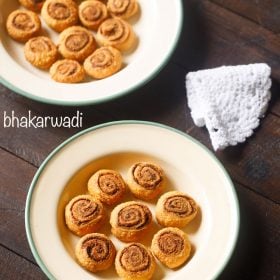
Could I use my air fryer to cook them?
You can try.
Hi,
Is there a substitute for khus-khus or can I skip it entirely? Will it impact the authentic taste of bhakarwadi significantly?
Thanks
There is no substitute for khus-khus. You can skip it entirely. There won’t me much taste change in the recipe except for that of the crunchiness coming from the khus khus.
I made excellent bhakarwadis with this recipe. Gives authentic maharashtrian taste.
thank you apurva for this super feedback on bhakarwadi recipe. so glad to read your comment. thanks for the rating too.